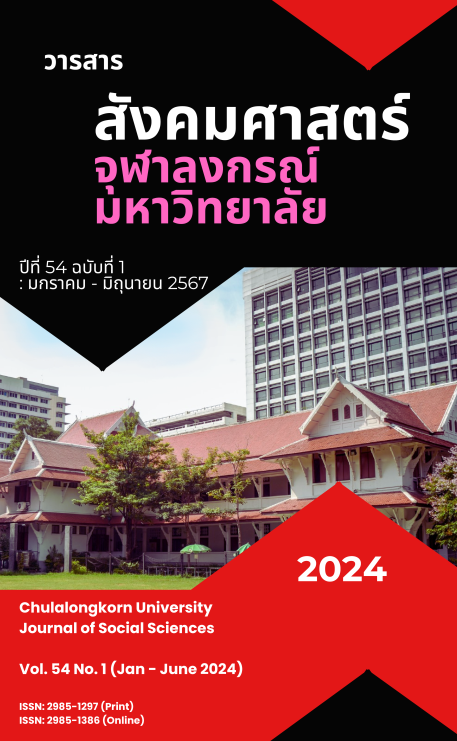จากจอบสู่จาน: เชฟส์ เทเบิล การกินอย่างมีหลักการ และ ภูมิทัศน์อาหารไทย
DOI:
https://doi.org/10.61462/cujss.v54i1.3139คำสำคัญ:
ฟาร์ม ทู ฟอร์ค, ฟาร์ม ทู เทเบิล, เซเลบริตี้ เชฟ, เชฟส์ เทเบิล, การกินอย่างมีหลักการ, ภูมิทัศน์อาหารบทคัดย่อ
การวิจัยเรื่อง “จากจอบสู่จาน: เชฟส์ เทเบิล การกินอย่างมีหลักการ และภูมิทัศน์อาหารไทย” มีวัตถุประสงค์เพื่อ (1) ศึกษาการกินอย่างมีหลักการและรูปแบบภูมิทัศน์อาหารไทย (2) ศึกษาแนวทางการเพิ่มมูลค่าทางเศรษฐกิจการกินอย่างมีหลักการ และ (3) เพื่อนำเสนอแนวทางการพัฒนาการกินอย่างมีหลักการสู่การเพิ่มมูลค่าทางเศรษฐกิจ กลุ่มตัวอย่าง คือ เชฟที่มีชื่อเสียง ซึ่งเป็นเจ้าของร้านอาหารที่ให้บริการประเภทเชฟส์ เทเบิล และหรือเป็นผู้ที่มีการนำหลักเรื่องการกินอย่างมีหลักการมาใช้เป็นแนวทางปฏิบัติ จำนวน 5 คน วิธีการวิจัยใช้การสังเกตการณ์แบบมีส่วนร่วม และการสัมภาษณ์กลุ่มบุคคลสำคัญ
ผลการวิจัย พบว่า (1) จริยธรรมด้านอาหารเป็นเรื่องเกี่ยวกับการเลือกที่เราเชื่อว่าดีและถูกต้องเกี่ยวกับอาหารที่เรากิน เชฟและผู้ร่วมงานสร้างสรรค์เมนูบนพื้นฐานของการคิดถึงห่วงโซ่อุปทานของระบบอาหารยั่งยืนที่สัมพันธ์ไปกับท้องถิ่น วัฒนธรรมและฤดูกาล (2) เมนูสร้างสรรค์ สัมพันธ์กับเรื่องราวของเชฟ ที่มาของวัตถุดิบ วิธีการปรุง วิธีปฏิบัติการเสิร์ฟอาหารและการจับคู่กับเครื่องดื่ม เป็นแนวทางการเพิ่มมูลค่าทางเศรษฐกิจการกินอย่างมีหลักการภายใต้ระบบเศรษฐกิจสร้างสรรค์ที่สามารถสร้างรายได้ให้กับธุรกิจอาหารและวิสาหกิจรายย่อย ควบคู่ไปกับการเชิดชูคุณค่าของวัฒนธรรมอาหารท้องถิ่น (3) การใช้ภูมิทัศน์อาหาร รวมถึงยกระดับอาหารท้องถิ่นมาสู่เมนูสร้างสรรค์ในร้าน เป็นแนวทางการพัฒนาการกินอย่างมีหลักการที่สามารถสร้างงานในชุมชนท้องถิ่นผ่านการผลิต/จัดหาวัตถุดิบ/แรงงานจากละแวกท้องถิ่น การศึกษาเน้นย้ำว่า การกินอย่างมีหลักการไม่เพียงแต่เป็นปฏิบัติการทางอาหารเท่านั้น แต่ยังเป็นตัวเร่งการเติบโตทางเศรษฐกิจและการพัฒนาชุมชนภายในภูมิทัศน์อาหารไทย และยังแสดงให้เห็นว่า สามารถทำหน้าที่เป็นกรอบในการศึกษาวัฒนธรรมอาหารร่วมสมัยในมิติทางสังคมวิทยาและมานุษยวิทยาต่อไปได้อีกด้วย
Downloads
เอกสารอ้างอิง
Batali, Mario, and Jim Webster. 2014. America--Farm to Table: Simple, Delicious Recipes Celebrating Local Farmers. Illustrated edition. New York: Grand Central Life & Style.
Beardsworth, Alan, and Teresa Keil. 1997. Sociology on the Menu. London: Routledge.
Bourdieu, Pierre. 1984. Distinction: A Social Critique of the Judgement of Taste. Translated by Richard Nice. Cambridge, Mass: Harvard University Press.
Coff, Christian. 2006. The Taste for Ethics: An Ethic of Food Consumption. 2006th edition. Dordrecht: Springer.
Dalzell, Rebecca. 2018. “What Made Oscar Tschirky the King of Gilded Age New York.” Smithsonian Magazine. https://www.smithsonianmag.com/history/what-made-oscar-tschirky-king-gilded-age-new-york-180968885/.
European Commission. 2021. “Foodscapes - Toward Food System Transition | Knowledge for Policy.” https://knowledge4policy.ec.europa.eu/publication/foodscapes-toward-food-system-transition_en.
Fanzo, Jessica, and Rebecca McLaren. 2020. “An Overview of the Ethics of Eating and Drinking.” In Handbook of Eating and Drinking: Interdisciplinary Perspectives, edited by Herbert L. Meiselman, 1095–115. Cham: Springer International Publishing. https://doi.org/10.1007/978-3-030-14504-0_82.
FAO, IFAD, UNICEF, WFP, & WHO. 2023. Urbanization, Agrifood Systems Transformation and Healthy Diets across the Rural-Urban Continuum. The State of Food Security and Nutrition in the World 2023. Rome: FAO. https://doi.org/10.4060/cc3017en.
FAO. 2011. “Global Food Losses and Food Waste: Extent, Causes and Prevention.” Rome. https://www.fao.org/4/mb060e/mb060e00.pdf.
Food Ethics Council. 2023. “What Is Food Ethics?” Food Ethics Council. https://www.foodethicscouncil.org/food-ethics/what-is-food-ethics/.
Furedi, Frank. 2010. “Celebrity Culture.” Society 47 (6): 493–97. https://doi.org/10.1007/s12115-010-9367-6.
Henderson, Joan C. 2011. “Celebrity Chefs: Expanding Empires.” British Food Journal 113 (5): 613–24. https://doi.org/10.1108/00070701111131728.
Leschziner, Vanina. 2015. At the Chef’s Table: Culinary Creativity in Elite Restaurants. 1st edition. Stanford, California: Stanford University Press.
MacKendrick, Norah. 2014. “Foodscape.” Contexts 13 (3): 16–18. https://doi.org/10.1177/1536504214545754.
Mintz, Sidney. 2019. “Time, Sugar, and Sweetness.” In Food and Culture: A Reader, edited by Carole Counihan, Penny Van Esterik, and Alice Julier, Fourth edition, 91–103. New York London: Routledge, Taylor & Francis Group.
Moyser, George. 2006. “Elite Interviewing.” In The SAGE Dictionary of Social Research Methods, edited by Victor Jupp, 1st edition, 85–86. London ; Thousand Oaks, Calif: SAGE Publications Ltd.
National Bureau of Agricultural Commodity and Food Standards. 2021. “Good Agricultural Practices for Food Crops (TAS 9001-2021).” [Kan Patibat Thang Kan Kaset Thi Di Samrap Phuet Ahan (MoKoSo. 9001-2564)]. Accessed https://e-book.acfs.go.th/Book_view/292
Nisa Buranapawang. 2022. “Traits of Chef Characters in Movies about Cooking.”[Khunnalaksana Khong Tualakhon Thi Prakop Achip Chep Nai Phapphayon Naeo Tham Ahan] Academic Journal of Humanities and Social Sciences Burapha University 30 (2):53-74. https://ojs.lib.buu.ac.th/index.php/huso2/article/view/8107 (in Thai)
Office of Agricultural Affairs, Royal Thai Embassy Brussels. 2020. “Khaosan Dan Kan Kaset SahaphapYurop Chabap Thi 33/2563.” [European Union Agricultural News no.33/2020] Accessed https://agrithai.be/uncategorized/eu-farm-to-form-strategy/. (in Thai)
Piyarat Panlee. 2022. “Chak Chop Su Chan: Chep The Boen Kan Kin Yang Mi Lakkan Lae Phum That Ahan Thai.”[From Farm to Fork: Chef’s Table, Ethical Eating, and Thai Foodscape] Bangkok: Faculty of Social Sciences, Kasetsart University. (in Thai)
Rayner, Jay. 2015. “Chef’s Table Is Another Slice of ‘cool Culinary’ Myth-Making.” The Guardian, April 22, 2015, sec. Television & radio. https://www.theguardian.com/tv-and-radio/tvandradioblog/2015/apr/22/chefs-table-cool-culinary-myth-making.
Sakeson Surapantapisit. 2011. “Thatsanakhati Khong Chep To Kan Okbaep Chut Chep Thi Mi Ekkalak Thai Phuea Chai Nai Khrua Ahan Thai Thi Mi Laksana Pen Khrua Poet.”[ Chef’s Attitude toward the Deigning of an Identity Thai Chef Apparel for Using in Open Thai Cuisine Kitchen] Master’s Thesis in Home Economics, Rajamangala University of Technology Phra Nakhon. https://lib.rmutp.ac.th/bibitem?bibid=b00083614. (in Thai)
Santos, Ana Rosa D., and Carina J. Mansey. 2022. “Latin America in the Chef’s Table: An Analysis of Gender and Inequalities in Netflix’s Documentary Series.” Anthropology of Food, no. S17 (June). https://doi.org/10.4000/aof.13328.
SkillsYouNeed. 2023. “Ethical Food Consumption.” SkillsYouNeed. https://www.skillsyouneed.com/ps/ethical-food-consumption.html.
Slow Food Foundation. n.d. “Our History.” Slow Food Foundation. https://www.slowfood.com/our-history/.
Statista. 2024. “Netflix Paid Subscribers Count by Region 2023.” Statista. https://www.statista.com/statistics/1090122/netflix-global-subscribers-by-region/.
Stringfellow, Lindsay, Andrew MacLaren, Mairi Maclean, and Kevin O’Gorman. 2013. “Conceptualizing Taste: Food, Culture and Celebrities.” Tourism Management 37 (August):77–85. https://doi.org/10.1016/j.tourman.2012.12.016.
Wasana Sitti-Issara. 2021. “Sunthariyasat Nai Satha Pattaya Kammakan Sep Ahan Chef’s Tables.”[Aesthetics within Architecture of Chef’s Tables] PhD Thesis in Architecture, Silpakorn University. http://ithesis-ir.su.ac.th:8080/jspui/handle/123456789/2525. (in Thai)
Warde, Alan. 1997. Consumption, Food and Taste: Culinary Antinomies and Commodity Culture. 1st edition. London; Thousand Oaks, Calif: SAGE Publications Ltd.
ดาวน์โหลด
เผยแพร่แล้ว
รูปแบบการอ้างอิง
ฉบับ
ประเภทบทความ
สัญญาอนุญาต
ลิขสิทธิ์ (c) 2024 คณะรัฐศาสตร์ จุฬาลงกรณ์มหาวิทยาลัย

อนุญาตภายใต้เงื่อนไข Creative Commons Attribution-NonCommercial-NoDerivatives 4.0 International License.
เงื่อนไขการอนุญาตสาธารณะ
นโยบายลิขสิทธิ์และการอนุญาต
วารสารสังคมศาสตร์ จุฬาลงกรณ์มหาวิทยาลัย เผยแพร่เนื้อหาทั้งหมดภายใต้ สัญญาอนุญาตครีเอทีฟคอมมอนส์แบบแสดงที่มา-ไม่ใช้เพื่อการค้า-ไม่ดัดแปลง 4.0 นานาชาติ (CC BY-NC-ND 4.0)
ลิขสิทธิ์
บทความทั้งหมดที่ตีพิมพ์ในวารสารสังคมศาสตร์ จุฬาลงกรณ์มหาวิทยาลัย เป็นลิขสิทธิ์ของ คณะรัฐศาสตร์ จุฬาลงกรณ์มหาวิทยาลัย ผู้เขียนจะโอนสิทธิ์ทั้งหมดให้แก่วารสารเมื่อบทความได้รับการตอบรับให้ตีพิมพ์
สัญญาอนุญาต CC BY-NC-ND 4.0
ภายใต้สัญญาอนุญาตนี้:
-
แสดงที่มา (BY): ผู้ใช้ต้องแสดงที่มาโดยอ้างอิงถึงผู้เขียน คณะรัฐศาสตร์ จุฬาลงกรณ์มหาวิทยาลัย และวารสารสังคมศาสตร์ จุฬาลงกรณ์มหาวิทยาลัย พร้อมทั้งให้ลิงก์ไปยังสัญญาอนุญาต และระบุหากมีการเปลี่ยนแปลง ทั้งนี้สามารถทำได้ในลักษณะที่สมเหตุสมผล แต่ต้องไม่ทำในลักษณะที่แสดงว่าผู้อนุญาตให้การรับรองผู้ใช้หรือการใช้งานดังกล่าว
-
ไม่ใช้เพื่อการค้า (NC): ผู้ใช้ไม่สามารถใช้เนื้อหาเพื่อวัตถุประสงค์ทางการค้า การใช้งานเชิงพาณิชย์จะต้องได้รับอนุญาตเป็นลายลักษณ์อักษรล่วงหน้าจากผู้เขียนและคณะรัฐศาสตร์ จุฬาลงกรณ์มหาวิทยาลัย
-
ไม่ดัดแปลง (ND): หากผู้ใช้นำเนื้อหาไปรวม ดัดแปลง หรือต่อยอด ผู้ใช้ไม่สามารถเผยแพร่งานที่ดัดแปลงนั้นได้ การดัดแปลงผลงานจะต้องได้รับอนุญาตเป็นลายลักษณ์อักษรล่วงหน้าจากผู้เขียนและคณะรัฐศาสตร์ จุฬาลงกรณ์มหาวิทยาลัย
นโยบายการเข้าถึงแบบเปิด
วารสารสังคมศาสตร์ จุฬาลงกรณ์มหาวิทยาลัย ให้การเข้าถึงเนื้อหาแบบเปิดโดยทันทีตามหลักการที่ว่าการทำให้งานวิจัยสามารถเข้าถึงได้อย่างเสรีแก่สาธารณะจะสนับสนุนการแลกเปลี่ยนความรู้ในระดับโลก ผู้ใช้สามารถอ่าน ดาวน์โหลด คัดลอก เผยแพร่ พิมพ์ ค้นหา หรือเชื่อมโยงไปยังเนื้อหาฉบับเต็มของบทความได้โดยไม่ต้องขออนุญาตล่วงหน้าจากผู้จัดพิมพ์หรือผู้เขียน ทั้งนี้เป็นไปตามสัญญาอนุญาต CC BY-NC-ND 4.0
นโยบายการเก็บบันทึกด้วยตนเอง
ผู้เขียนสามารถเก็บบันทึกบทความฉบับตีพิมพ์สุดท้าย ต้นฉบับที่ส่ง (preprint) หรือฉบับที่ผ่านการประเมิน (postprint) ในคลังสถาบันหรือเว็บไซต์ส่วนตัวได้ โดยต้องมีการอ้างอิงการตีพิมพ์ครั้งแรกในวารสารสังคมศาสตร์ จุฬาลงกรณ์มหาวิทยาลัย พร้อมระบุแหล่งอ้างอิงที่สมบูรณ์และลิงก์ไปยังเว็บไซต์ของวารสาร
การขออนุญาต
สำหรับการใช้งานนอกเหนือจากที่ครอบคลุมโดยสัญญาอนุญาต CC BY-NC-ND 4.0 กรุณาติดต่อ:
กองบรรณาธิการ
วารสารสังคมศาสตร์ จุฬาลงกรณ์มหาวิทยาลัย
คณะรัฐศาสตร์ จุฬาลงกรณ์มหาวิทยาลัย
Email: cusocscij@gmail.com
สำหรับข้อมูลเพิ่มเติมเกี่ยวกับสัญญาอนุญาตครีเอทีฟคอมมอนส์แบบแสดงที่มา-ไม่ใช้เพื่อการค้า-ไม่ดัดแปลง 4.0 นานาชาติ กรุณาเยี่ยมชม: https://creativecommons.org/licenses/by-nc-nd/4.0/deed.th





